Abstract
A basal (BC) medium devoid of added carbohydrates, a complete (CC) medium containing nine carbohydrates were developed for enumerating rumen bacteria. The colony counts on the BC medium were 85 to 100% of those obtained on the CC medium. These colonies were pinpoint size (less than or equal to mm in diameter) but increased in size (2 to 5 mm in diameter) when carbohydrates were subsequently added. With the CC medium or other media tested, the colony counts were 20 to 50% higher on plates than on roll tubes and were about 35% of the direct cell counts. The lower colony counts on roll tubes were shown to result primarily from the loss of viability due to heat stress. The DC media were found by plating techniques to be suitable for differentiating mixed rumen bacterial populations into subgroups based upon carbohydrate utilization as shown by differences in subgroup profiles found within solid and liquid fractions of rumen contents, within rumen contents from animals fed high-forage and high-grain diets, and by correct colony formations by pure cultures of rumen bacteria on appropriate DC media. With simple modifications and use of an anaerobic glove box, replica plating methods and the CC and DC media were found to be a suitable means of rapidly determining the range of utilizable carbohydrate energy sources of rumen bacteria.
Full text
PDF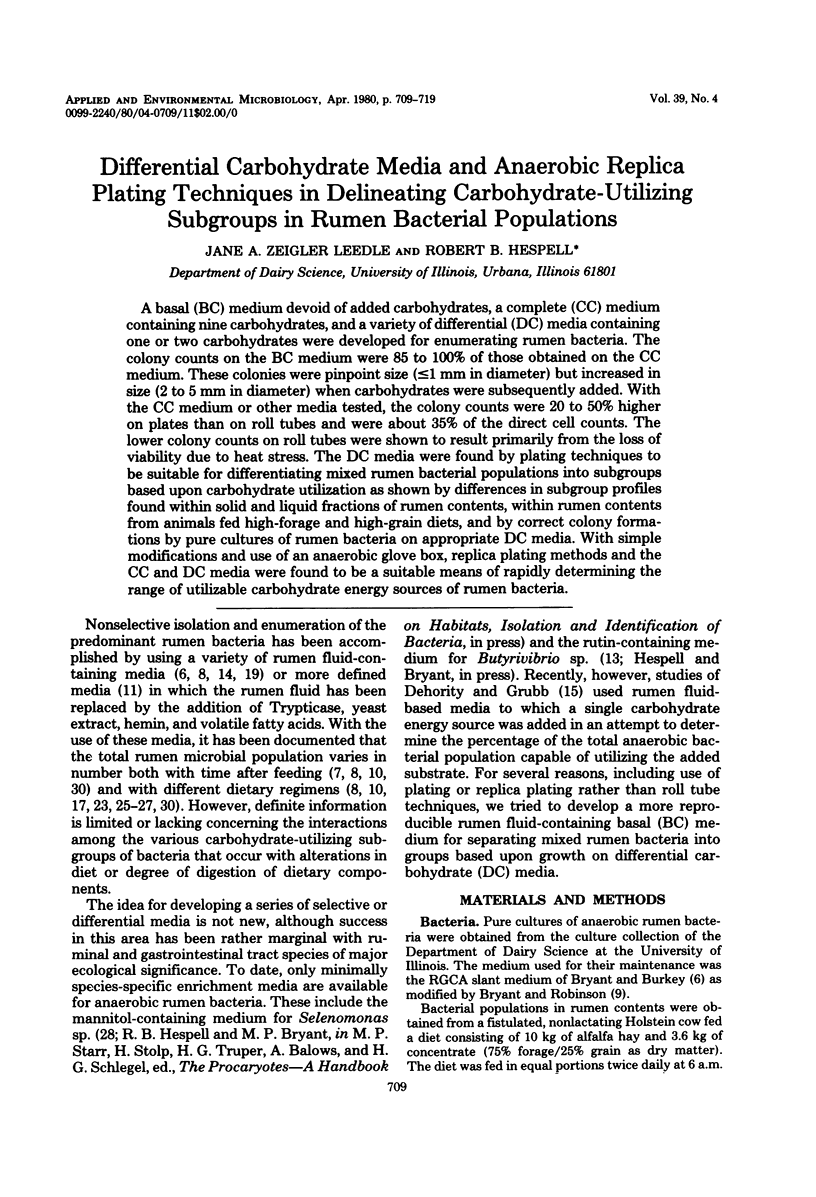
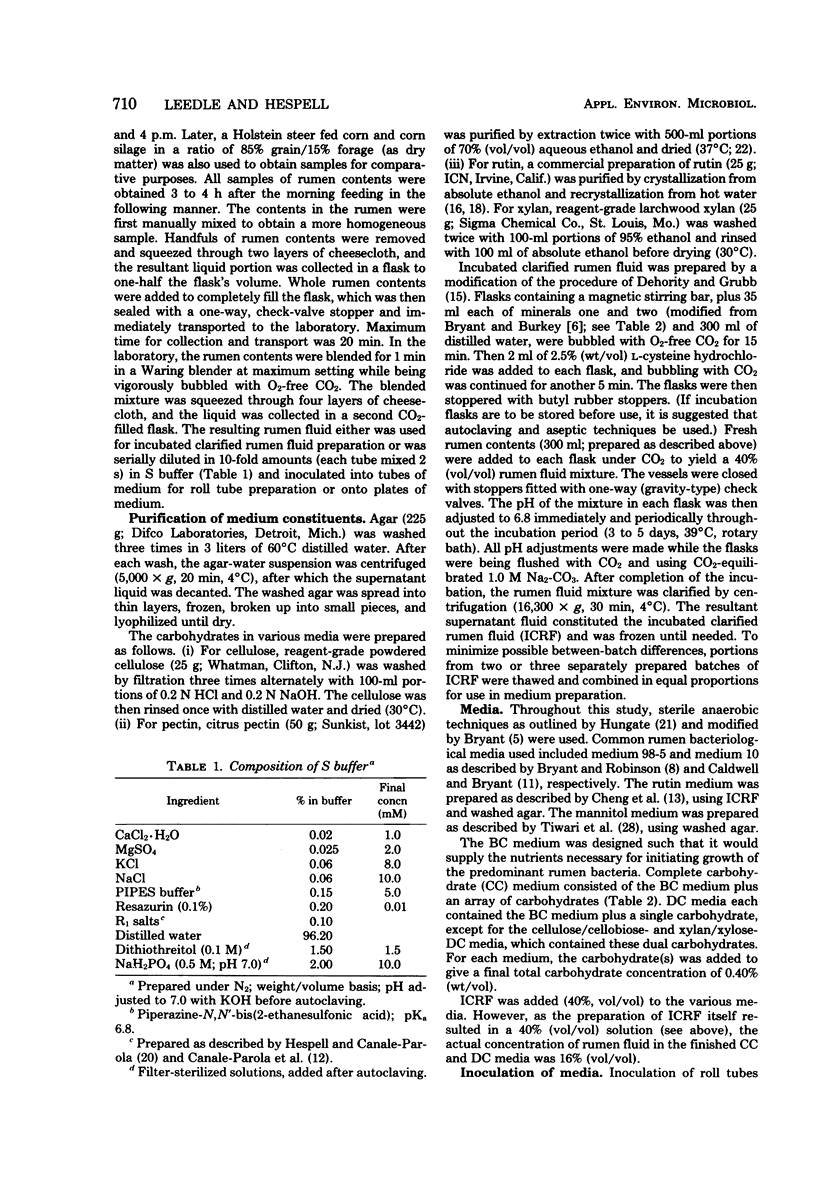
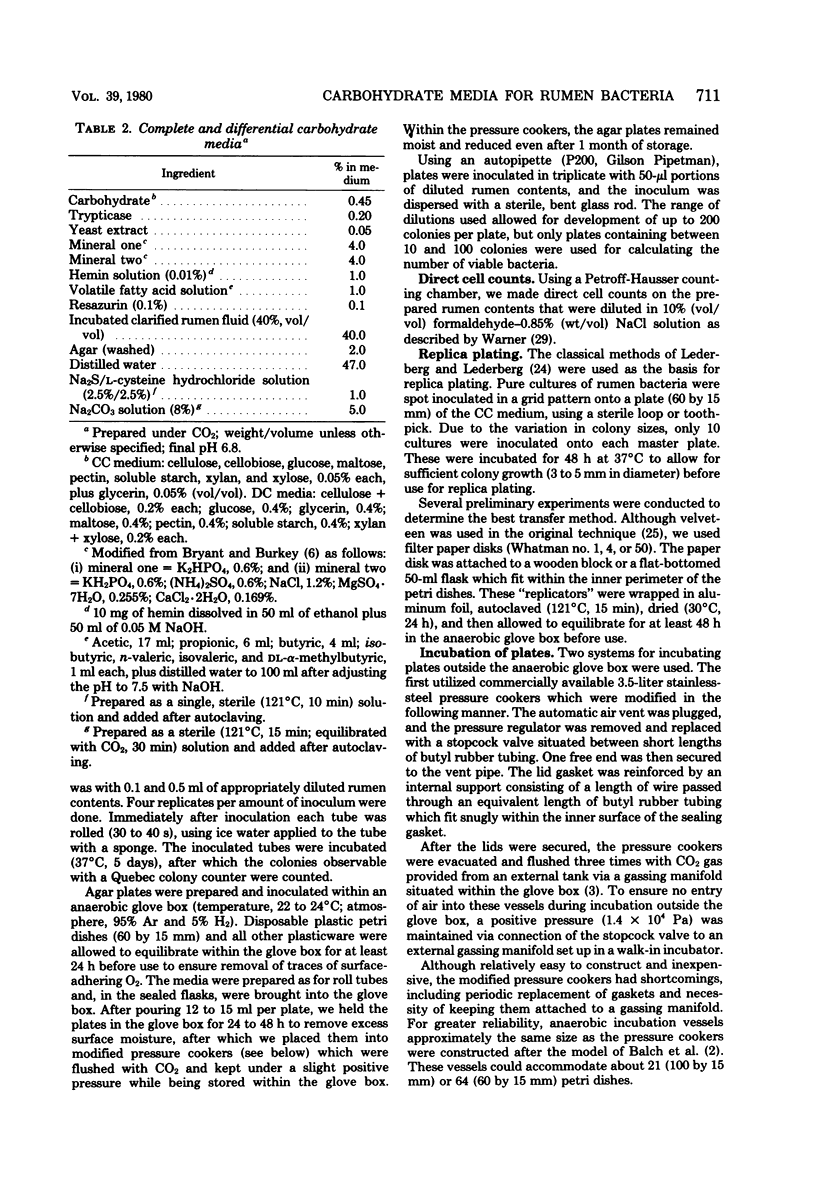
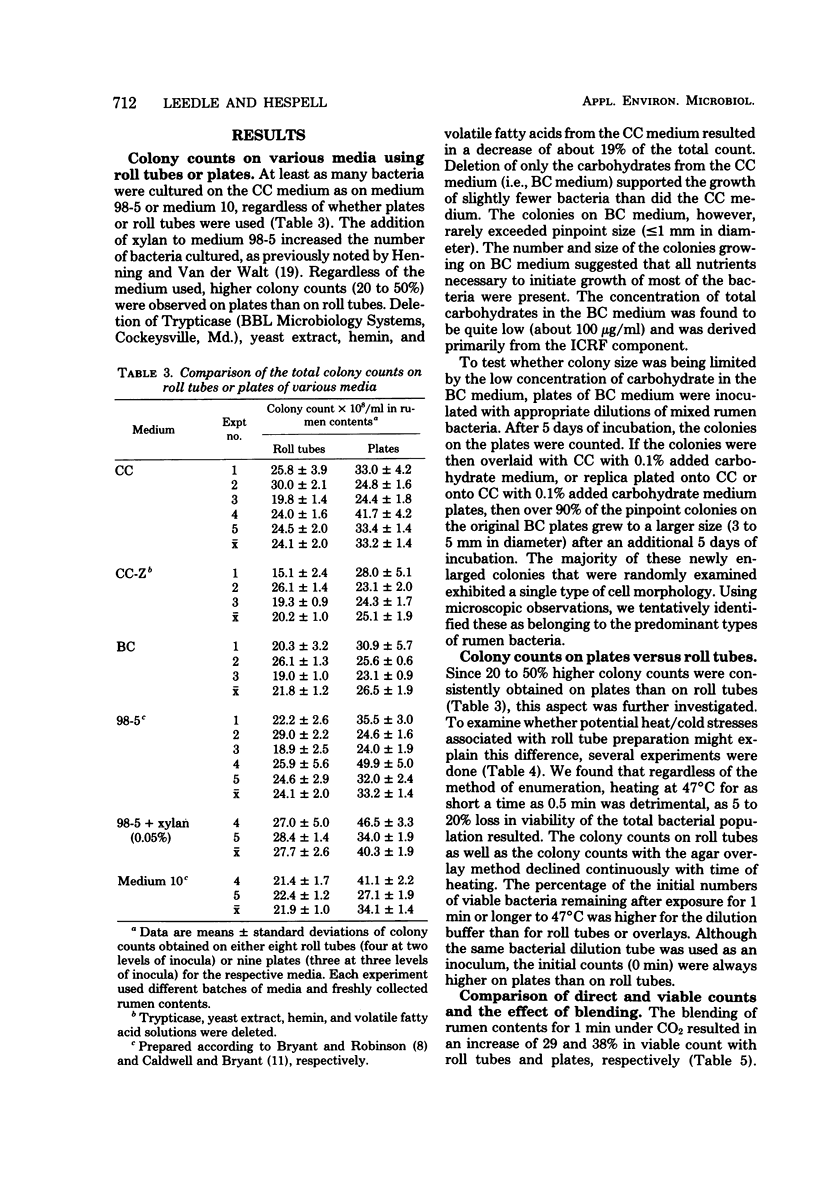
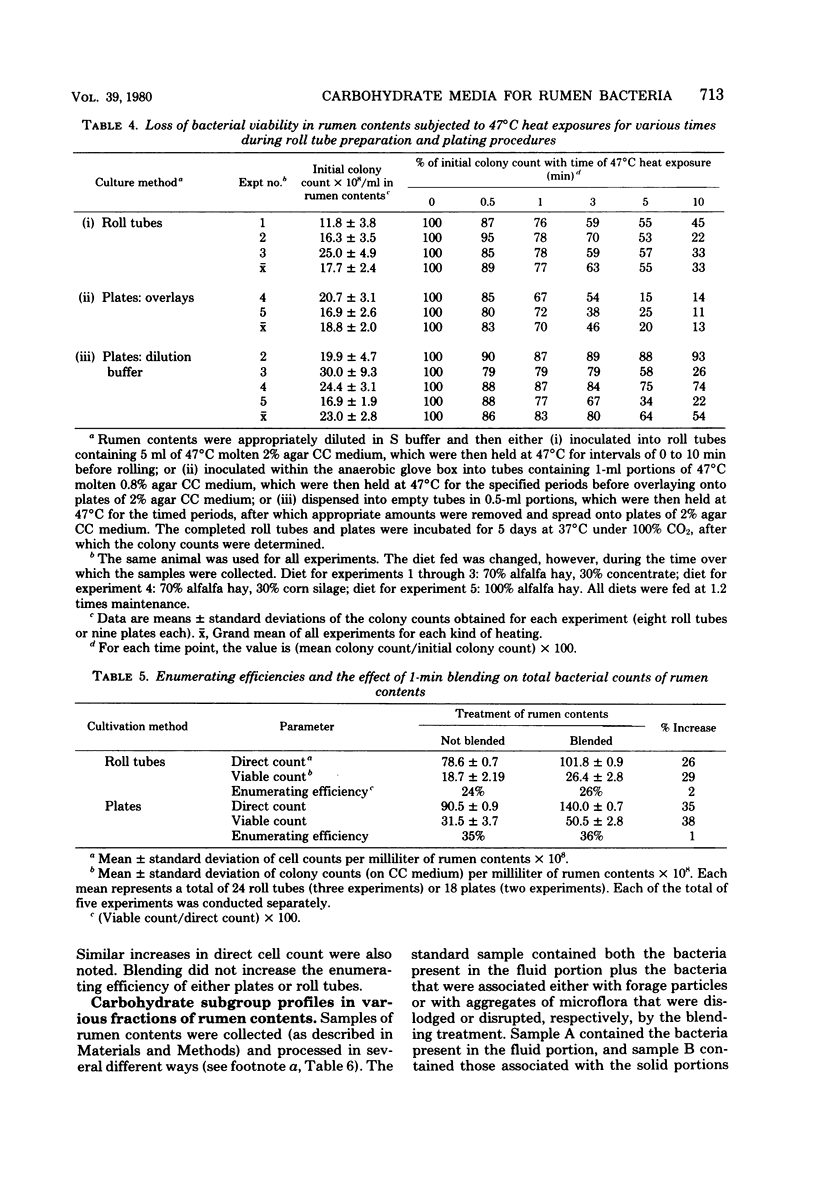
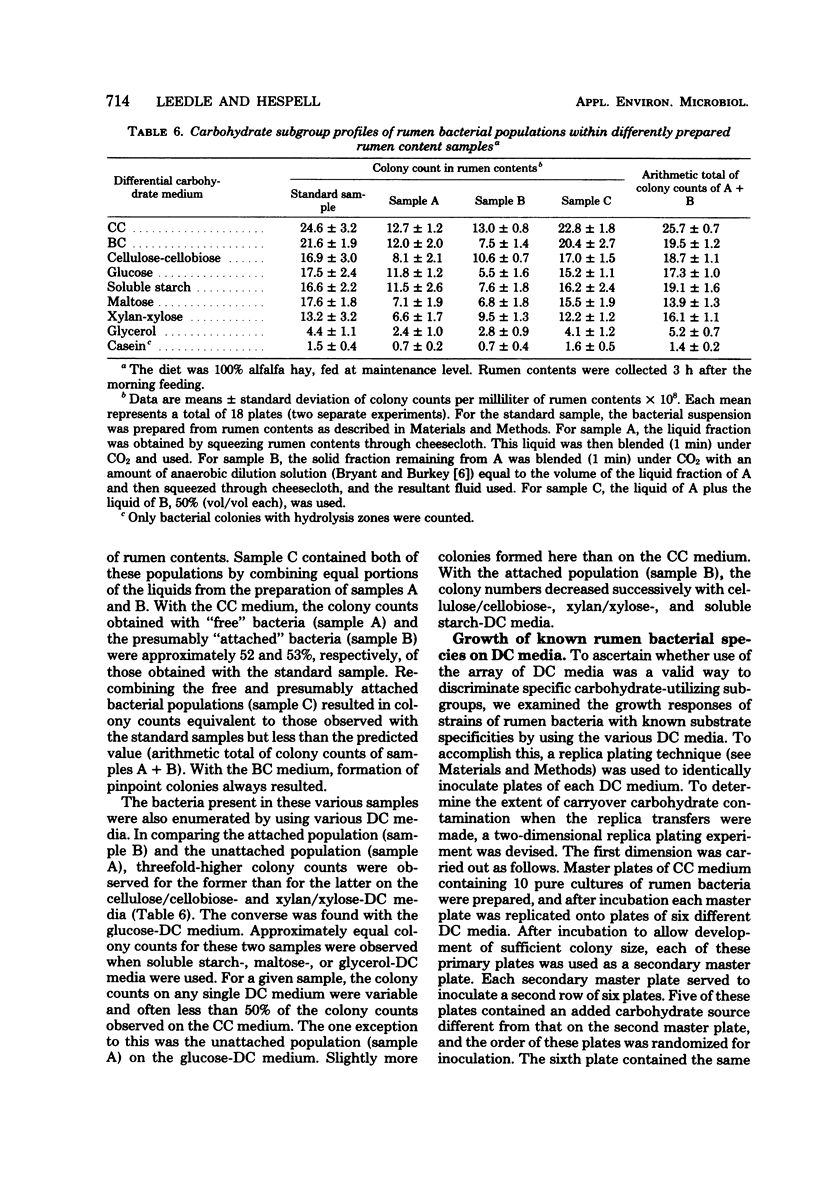
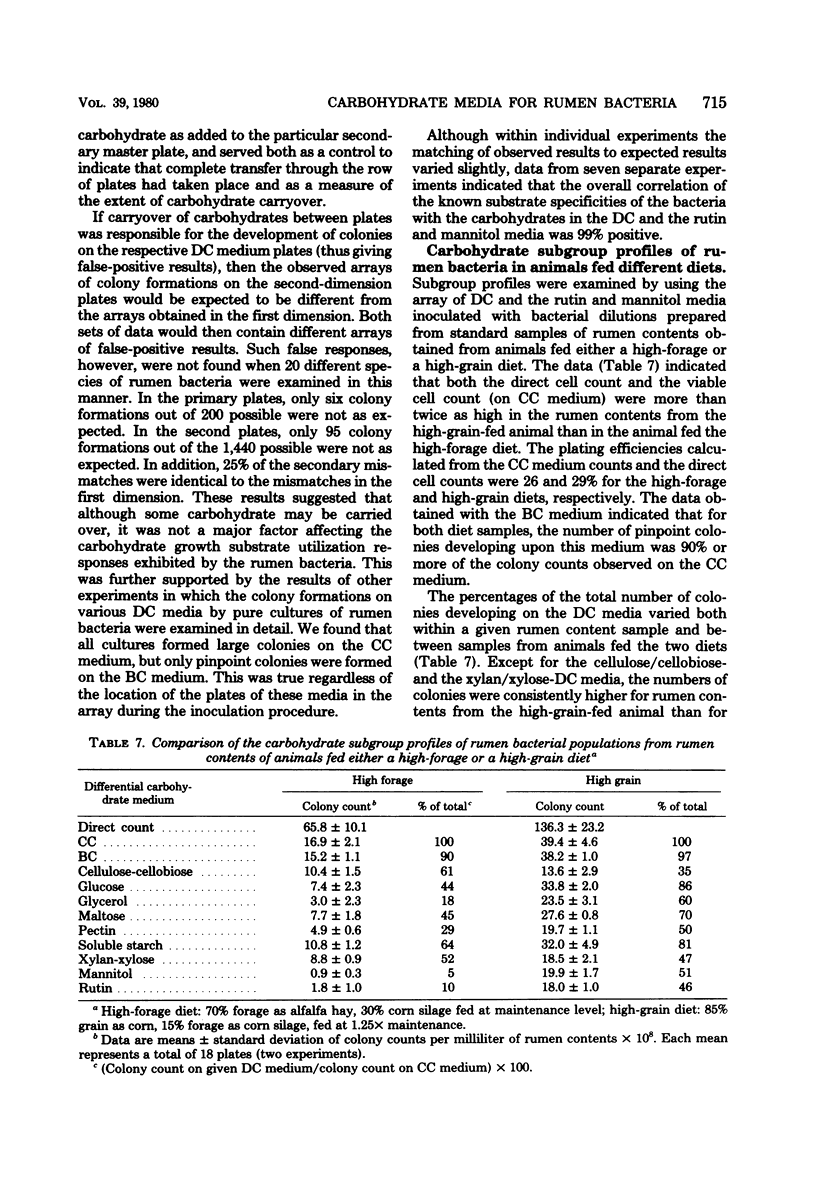
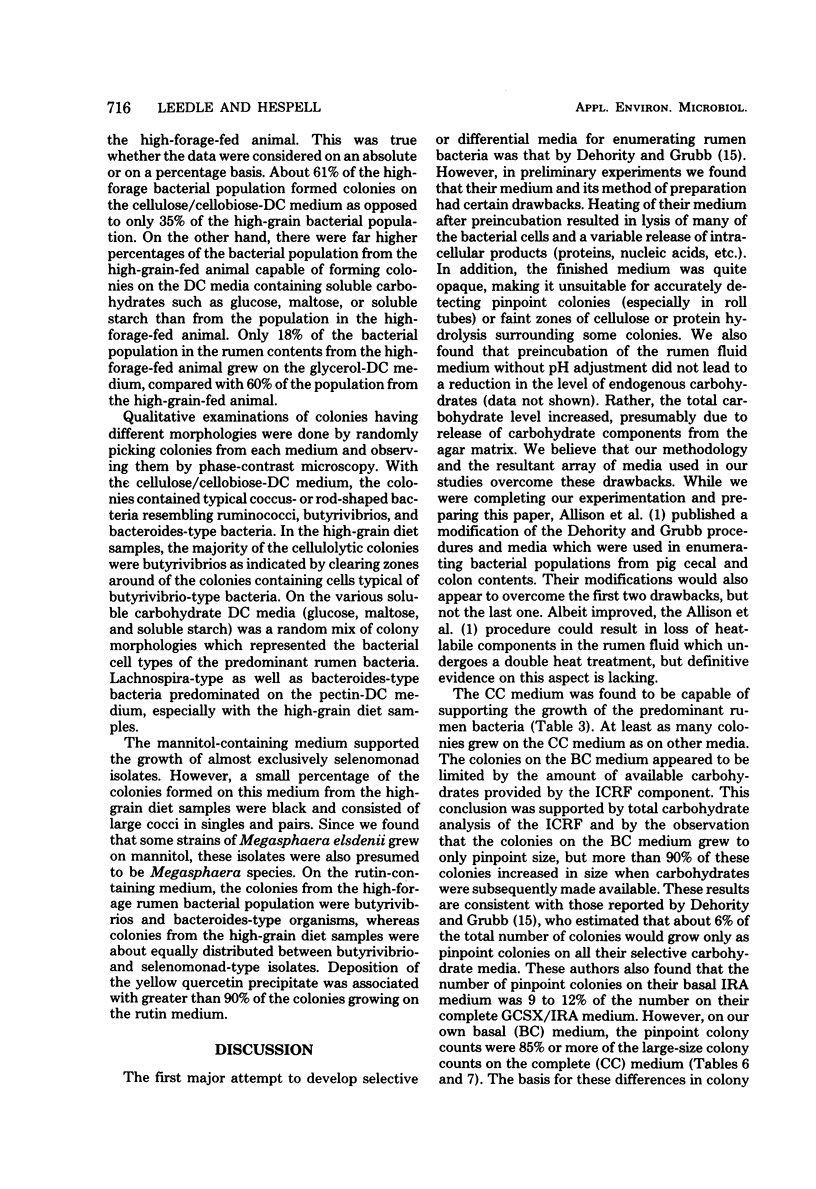
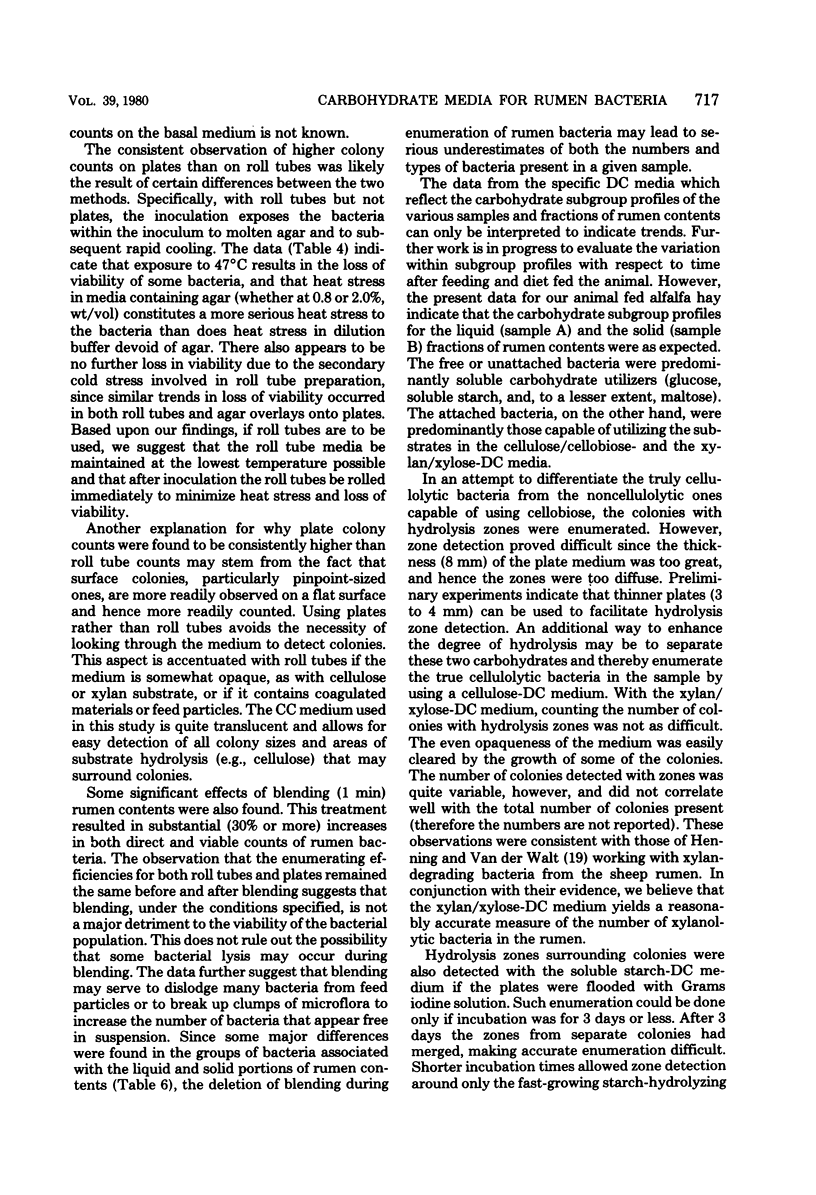
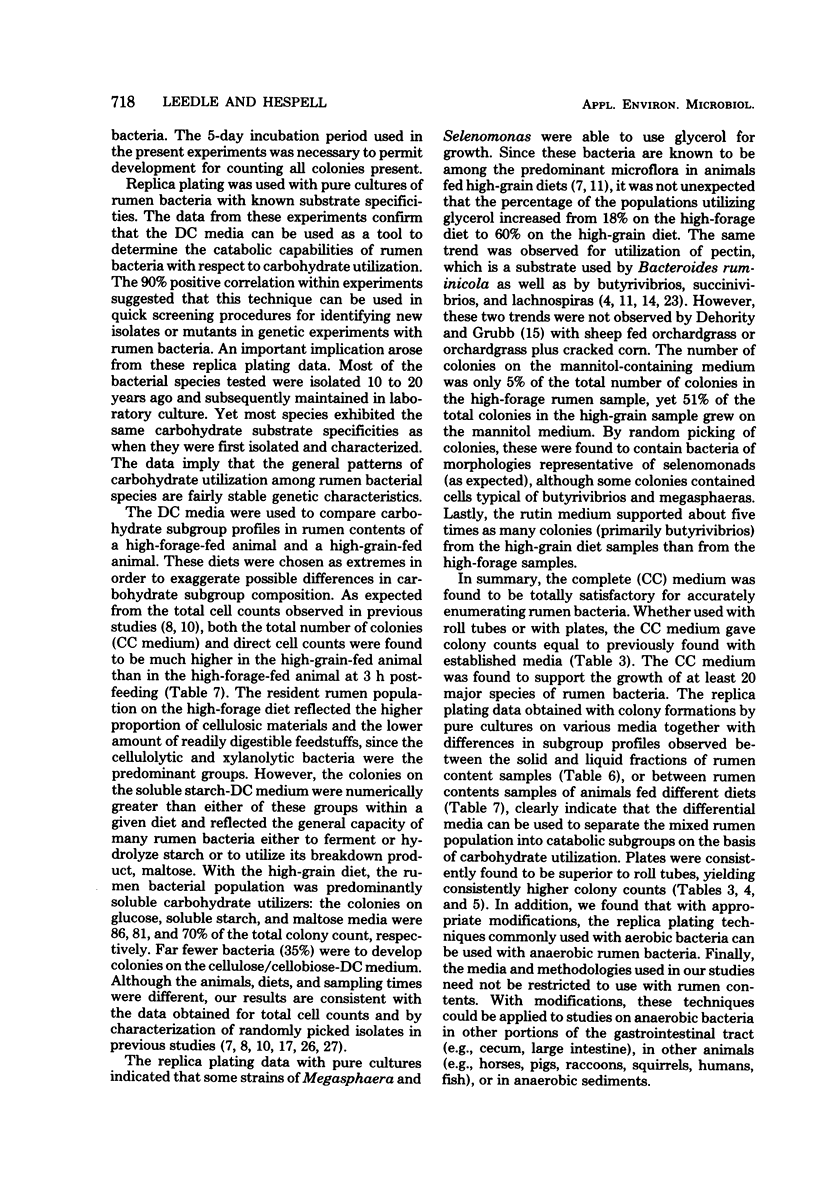
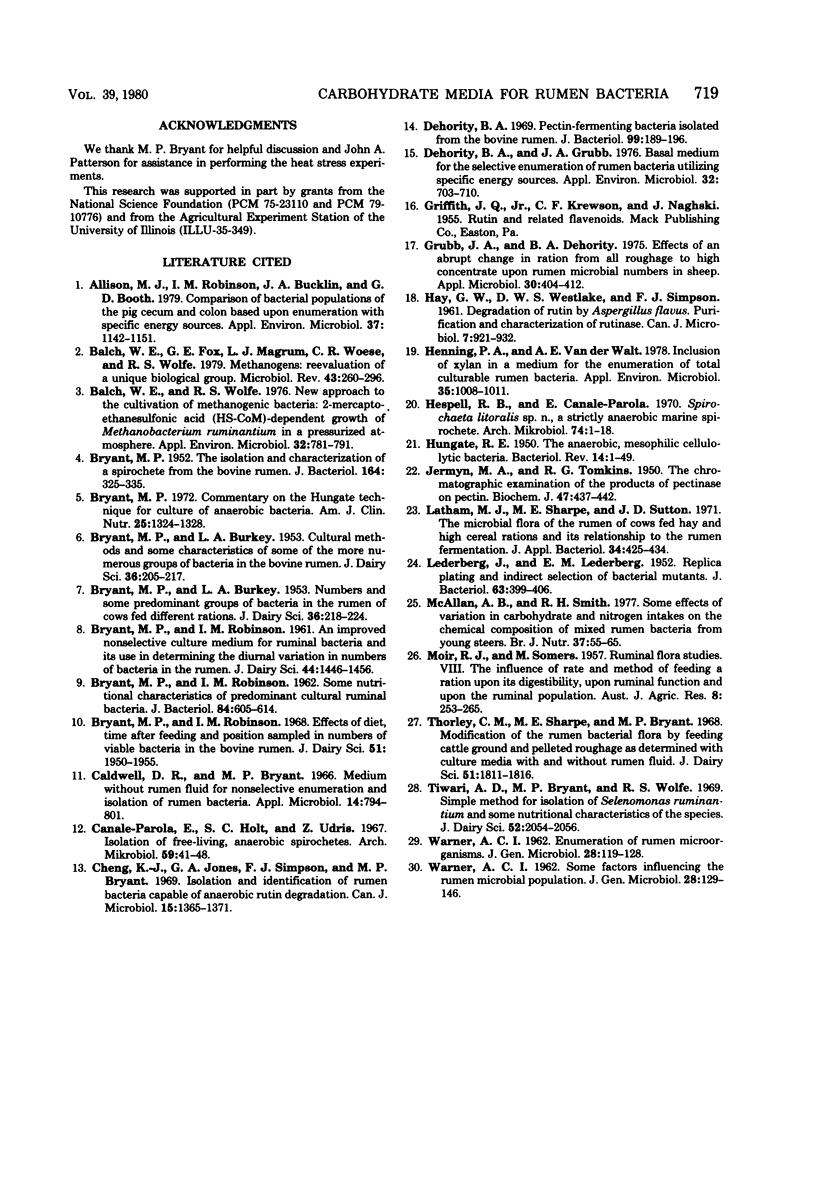
Selected References
These references are in PubMed. This may not be the complete list of references from this article.
- Allison M. J., Robinson I. M., Bucklin J. A., Booth G. D. Comparison of bacterial populations of the pig cecum and colon based upon enumeration with specific energy sources. Appl Environ Microbiol. 1979 Jun;37(6):1142–1151. doi: 10.1128/aem.37.6.1142-1151.1979. [DOI] [PMC free article] [PubMed] [Google Scholar]
- BRYANT M. P., ROBINSON I. M. Some nutritional characteristics of predominant culturable ruminal bacteria. J Bacteriol. 1962 Oct;84:605–614. doi: 10.1128/jb.84.4.605-614.1962. [DOI] [PMC free article] [PubMed] [Google Scholar]
- BRYANT M. P. The isolation and characteristics of a spirochete from the bovine rumen. J Bacteriol. 1952 Sep;64(3):325–335. doi: 10.1128/jb.64.3.325-335.1952. [DOI] [PMC free article] [PubMed] [Google Scholar]
- Balch W. E., Fox G. E., Magrum L. J., Woese C. R., Wolfe R. S. Methanogens: reevaluation of a unique biological group. Microbiol Rev. 1979 Jun;43(2):260–296. doi: 10.1128/mr.43.2.260-296.1979. [DOI] [PMC free article] [PubMed] [Google Scholar]
- Balch W. E., Wolfe R. S. New approach to the cultivation of methanogenic bacteria: 2-mercaptoethanesulfonic acid (HS-CoM)-dependent growth of Methanobacterium ruminantium in a pressureized atmosphere. Appl Environ Microbiol. 1976 Dec;32(6):781–791. doi: 10.1128/aem.32.6.781-791.1976. [DOI] [PMC free article] [PubMed] [Google Scholar]
- Bryant M. P. Commentary on the Hungate technique for culture of anaerobic bacteria. Am J Clin Nutr. 1972 Dec;25(12):1324–1328. doi: 10.1093/ajcn/25.12.1324. [DOI] [PubMed] [Google Scholar]
- Bryant M. P., Robinson I. M. Effects of diet, time after feeding, and position sampled on numbers of viable bacteria in the bovine rumen. J Dairy Sci. 1968 Dec;51(12):1950–1955. doi: 10.3168/jds.S0022-0302(68)87320-5. [DOI] [PubMed] [Google Scholar]
- Caldwell D. R., Bryant M. P. Medium without rumen fluid for nonselective enumeration and isolation of rumen bacteria. Appl Microbiol. 1966 Sep;14(5):794–801. doi: 10.1128/am.14.5.794-801.1966. [DOI] [PMC free article] [PubMed] [Google Scholar]
- Canale-Parola E., Holt S. C., Udris Z. Isolation of free-living, anaerobic spirochetes. Arch Mikrobiol. 1967;59(1):41–48. doi: 10.1007/BF00406315. [DOI] [PubMed] [Google Scholar]
- Cheng K. J., Jones G. A., Simpson F. J., Bryant M. P. Isolation and identification of rumen bacteria capable of anaerobic rutin degradation. Can J Microbiol. 1969 Dec;15(12):1365–1371. doi: 10.1139/m69-247. [DOI] [PubMed] [Google Scholar]
- Dehority B. A., Grubb J. A. Basal medium for the selective enumeration of rumen bacteria utilizing specific energy sources. Appl Environ Microbiol. 1976 Nov;32(5):703–710. doi: 10.1128/aem.32.5.703-710.1976. [DOI] [PMC free article] [PubMed] [Google Scholar]
- Dehority B. A. Pectin-fermenting bacteria isolated from the bovine rumen. J Bacteriol. 1969 Jul;99(1):189–196. doi: 10.1128/jb.99.1.189-196.1969. [DOI] [PMC free article] [PubMed] [Google Scholar]
- Grubb J. A., Dehority B. A. Effects of an abrupt change in ration from all roughage to high concentrate upon rumen microbial numbers in sheep. Appl Microbiol. 1975 Sep;30(3):404–412. doi: 10.1128/am.30.3.404-412.1975. [DOI] [PMC free article] [PubMed] [Google Scholar]
- HAY G. W., WESTLAKE D. W., SIMPSON F. J. Degradation of rutin by Aspergillus flavus. Purification and characterization of rutinase. Can J Microbiol. 1961 Dec;7:921–932. doi: 10.1139/m61-117. [DOI] [PubMed] [Google Scholar]
- HUNGATE R. E. The anaerobic mesophilic cellulolytic bacteria. Bacteriol Rev. 1950 Mar;14(1):1–49. doi: 10.1128/br.14.1.1-49.1950. [DOI] [PMC free article] [PubMed] [Google Scholar]
- Henning P. A., van der Walt A. E. Inclusion of xylan in a medium for the enumeration of total culturable rumen bacteria. Appl Environ Microbiol. 1978 Jun;35(6):1008–1011. doi: 10.1128/aem.35.6.1008-1011.1978. [DOI] [PMC free article] [PubMed] [Google Scholar]
- JERMYN M. A., TOMKINS R. G. The chromatographic examination of the products of the action of pectinase on pectin. Biochem J. 1950 Oct;47(4):437–442. doi: 10.1042/bj0470437. [DOI] [PMC free article] [PubMed] [Google Scholar]
- LEDERBERG J., LEDERBERG E. M. Replica plating and indirect selection of bacterial mutants. J Bacteriol. 1952 Mar;63(3):399–406. doi: 10.1128/jb.63.3.399-406.1952. [DOI] [PMC free article] [PubMed] [Google Scholar]
- Latham M. J., Sharpe M. E., Sutton J. D. The microbial flora of the rumen of cows fed hay and high cereal rations and its relationship to the rumen fermentation. J Appl Bacteriol. 1971 Jun;34(2):425–434. doi: 10.1111/j.1365-2672.1971.tb02302.x. [DOI] [PubMed] [Google Scholar]
- McAllan A. B., Smith R. H. Some effects of variation in carbohydrate and nitrogen intakes on the chemical composition of mixed rumen bacteria from young steers. Br J Nutr. 1977 Jan;37(1):55–65. doi: 10.1079/bjn19770007. [DOI] [PubMed] [Google Scholar]
- WARNER A. C. Enumeration of rumen micro-organisms. J Gen Microbiol. 1962 Apr;28:119–128. doi: 10.1099/00221287-28-1-119. [DOI] [PubMed] [Google Scholar]
- WARNER A. C. Some factors influencing the rumen microbial population. J Gen Microbiol. 1962 Apr;28:129–146. doi: 10.1099/00221287-28-1-129. [DOI] [PubMed] [Google Scholar]


